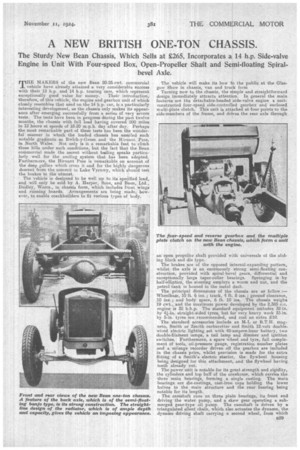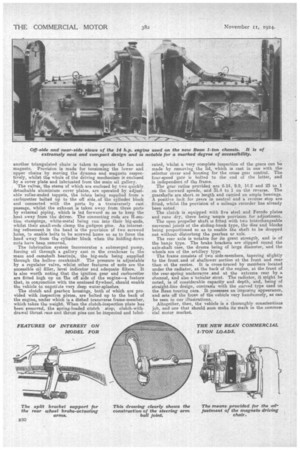A NEW BRITISH ONE-TON CHASSIS.
Page 13

Page 14

If you've noticed an error in this article please click here to report it so we can fix it.
The Sturdy New Bean Chassis, Which Sells at £265, Incorporates a 14 h.p. Side-valve Engine in Unit With Four-speed Box, Open-Propeller Shaft and Semi-floating Spiral bevel Axle.
THE MAKERS of the new Bean 20-25,cvqt. commercial vehicle have already attained a very considerable success with their 12 h.p. and 14 h.p. touringcars, which represent
exceptionally good value for money. Their introduction, therefore, of this vehicle, the engine and gearbox Unit of which closely resembles that used on the 14 h.p. car, is a particularly interesting development, as the chassis only makes its appearance after emerging successfully from a series of very severe tests. The tests have been in progress during the past twelve months, the chassis with full, load having covered 200 miles in 12 hours at speeds of 18-20 m.p.h. day after day. Perhaps the most remarkable part of these tests has been the wonderful manner in which the loaded chassia has assailedsuch notable gradients as Bwich-y-Groes and the Ilirnant Pass, in North Wales. Not only is it a remarkable feat to climb these hills under such conditions, but the fact that the Bean commercial made the ascent without bailing speaks particularly well for the cooling system that has been adopted. Furthermore, the Blirnant Pass is remarkable, on account of the deep gullies which cross it and for the highly dangerous descent from the summit to Lake Vyrnwy, which" should test the brakes to the utmost.
The vehicle is designed to be well up to its specified load, and will only be sold by A. Harper, Sons, and Bean, Ltd., Dridldy, Worcs., in chassis form, which includes front wings and running boards. Arrangements are being made, however, to enable coachbuilders to fit various types of body. The vehicle will make its bow to the public at the Glasgow Show in chassis, van and truck form
Turning now to the ehassis, the simple and straightforward design immediately attracts attention. In general the main features are the detachable-headed side-valve engine. a unitconstructed four-speed side-controlled gearbox and enclosed multi-plate clutch. This unit is attached at four points to the side-members of the frame, and drives the rear axle through
an open propeller shaft provided with universals of the sliding block and die type.
The brakes are of the opposed internal-expanding pattern, whilst the axle is an enormously strong semi-floating construction, provided with spiral-bevel gears, differential and exceptionally large taper-roller bearings. Springing is by half-ellipties, the steering employs a worm and nut, and the petrol tank is housed in the metal dash.
The principal dimensions of the chassis are as follow :— Wheelbase, 10 ft. 6 ins. ; track, 4 ft. 8 ins. ; ground clearance, 10 ins.; and body space, 6 ft. 10 ins. The chassis weighs 19 cwt., and the maximum power developed by the 2,385 c.c. engine is 32 h.h.p. The standard equipment meludes 32-in.
by straight-sided tyres, but for very heavy work 33-in. by 5-in. tyres are recominended, and cost an extra 10.
The standard accessories include an M-L or B.T.II. magneto, Smith or Zenith carburetter and Smith 12-volt doublewired electric lighting set with 48-ampere-hoar battery, two double-filainent lamps, a tail lamp and dimmer and ignition switches. Furthermore, a spare wheel and tyre, full complement of tools., oil-pressure gauge, registration number plates and a mileage recorder driven off the gearbox are included in the chassis price, whilst provision is made for the extra fitting of a Smith's electric starter, the flywheel housing being designed for this attachment, and the flywheel having teeth already cut..
The power unit is notable for its great strength and rigidity, the cylinders and top half of the crankcase, which carries the three main bearings, forming a single casting. The main bearings are die-castings, cast-iron caps holding the lower halves to the main structure and the rear bearing being notable for its length.
The camshaft runs on three plain bearings, its front end driving the water pump, and a skew gear operating a submerged gear-type oil pump. The camshaft is driven by a triangulated silent chain, which also actuates the dynamo, the dynamo driving shaft carrying a second wheel, from which another triangulated chain is taken to operate the fan and magneto. Provision is made for tensioning the lower and upper chains by moving the dynamo and magneto respectively, whilst the whole of the driving mechanism is enclosed by a cover plate and lubricated from the main oil gallery.
The valves, the stems of which are enclosed by two quickly detachable aluminium cover plates, are operated by adjustable roller-ended tappets, the inlets being supplied from a carburetter bolted up to the off side of the cylinder block and connected with the ports by a transversely cast passage, whilst the exhaust is taken away from three ports by external piping, which is led forward so as to keep the heat away from the driver. The connecting rods are H-section stampings, white-metal being run, into their big-ends, whilst their small-ends clamp the gudgeon pins. An interesting refinement in the head is the provision of two screwed holes, to enable bolts to he screwed home so as to force the head away from the cylinder block when the holding-down nuts have been removed..
The lubrication system incorporates a submerged pump, forcing oil through a gallery cast in the crankcase to the main and camshaft bearings, the big-ends being supplied through the hollow crankshaft, The pressure is adjustable by a regulator valve, whilst other features of note are the accessible oil filler, level indicator and adequate filters. It is also worth noting that the ignition gear and carburetter are fitted high up on The off side of the engine—a feature that, in conjunction with the enclosed flywheel, should enable the vehicle to negotiite very deep water-splashes. The clutch and gearbox housings, both of which are pro. vided with inspection plates, are bolted up to the back of the engine, under which is a dished transverse frame-member, which takes the weight. When the clutch.inspection plate has been removed, the spring-loaded clutch stop; clutch-withdrawal thrust race anl thrust pins can be inspected and lubri cated, whilst a very complete inspection of the gears can be made by removing the lid, which is cast in one with the selector cover and housing for the cross gem control. The four-speed gate is bolted to the end of the latter, and is independent of the frame.
The gear ratios provided are 6.14, 9.9, 14.2 and 23 to 1 on the forward speeds, and 31.4 to 1 on the reverse. The gearshafts are short m length and carried on ample bearings. A positive lock for gears in neutral and a reverse stop are fitted, whilst the provision of a mileage recorder'has already been noted.
The clutch is .equipped with five steel anti Ferodo plates and runs dry, there being ample provision for adjustment.
The open propeller shaft is fitted with two interchangeable universal jointS of the sliding-block type, the dies and blocks being proportioned so as ta enable the shaft to be dropped out without disturbing the -'gearbox or axle.
The rear axle is notable for its great strength, and is of the banjo type. The brake brackets are clipped round the axle-shaft case, the drums being of large diameter, and the wheels are of the artillery type. The frame consists of two side-members, tapering slightly to the front and of shallower section at the front and rear than at the centre. it is cross-bracedby members located_ under the radiator, at the back of the engine, at the front of the rear-spring anchorages and at the extreme rear by a channel, and also a tubular strut. The radiator, it might be noted, is of considerable capacity and depth, and, being of straight-line design, contrasts with the curved type used on the Bean touring cars. It possesses an imposing appearance, and sets off the front of the vehicle very handsomely, as can be seen in our illustrations.
Altogether, then, the vehicle is a thoroughly conscientious job, and one that should soon make its mark in the commexcial motor market.






























